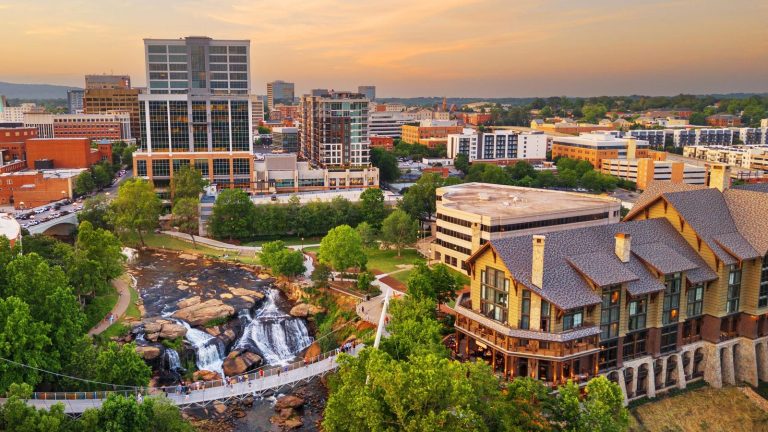Forbes compared more than 950 locales in America on everything from housing costs and taxes to healthcare, air quality, crime and climate change and natural hazard risk. These are the top 25 cities for retirees.
After years spent enduring high taxes and four-hour-long round-trip commutes to his job in Los Angeles as an insurance adjuster for large commercial claims, Andy Costa wanted to escape in retirement from the costs and hectic pace of Southern California. And like many folks contemplating retirement, Andy and his wife, Doreen, a retired middle school teacher, also wanted to be near family. So last year, the Costas, both now 62, sold their home in Rancho Santa Margarita in Orange County and bought one on the outskirts of Greenville, South Carolina, that cost hundreds of thousands less and was 90% larger—big enough, in fact, that their daughter, son-in-law and two grandkids, age 4 and 2, moved in with them. How is intergenerational living going in this fast-growing area at the foot of the Blue Ridge Mountains? “Terrific,” Andrew says. “And there’s no traffic.”
Greenville is one of the 25 picks on Forbes’ Best Places To Retire In 2025 list, which highlights locales offering a high quality of life in the U.S. at a comparatively affordable price. We compared more than 950 sites, with housing costs being a major factor. Since 2020, the median price of single-family homes nationwide has jumped 50% to $404,000, according to the National Association of Realtors. Greenville, for its part, has a median home price of just $317,000, 22% below the national median, contributing to an overall cost of living that’s 9% below average.
By design, 22 of the 25 places on our new list have median home prices at or below the national median and four—Iowa City, Iowa; Lincoln, Nebraska; Pittsburgh, Pennsylvania; and San Antonio, Texas—are under $300,000. Only three honorees have a median home price above the national one, with the most expensive being Raleigh, North Carolina, at $440,000, 9% above the national median. The next highest, college town and state capital Madison, Wisconsin, weighs in at $408,00, just 1% above the national median, while new-to-the-list Pasco, Washington, 225 miles southwest of Seattle, is $406,000. The median price in The Villages, our sole Florida pick, sits at $404,000, the national median. (You can read about the intriguing way one couple settled on The Villages here.)
Overall, our new list features choices in 19 states and all four domestic time zones, with a roughly even split between colder and warmer climates. Chilly Fargo, North Dakota, is the only city appearing for all 15 years we’re compiled this list. Pittsburgh, which also has frosty winters, is another of our perennial favorites—on the list for 13 of 15 years and for the eighth year in a row, despite its above-average crime rate. Besides basic costs, our selection process weighs such metrics as state taxes, prospects for the local economy, air quality, serious crime and the availability of primary care doctors, as well as whether a place encourages an active lifestyle by making biking or walking convenient. As we have since 2020, we screen for natural hazard and climate change risk, ruling out places with the very highest danger, as measured by the Federal Emergency Management Agency (FEMA) National Risk Index, which evaluates 18 natural hazards ranging from hurricanes and tornadoes to heat waves and extreme cold.
Downtown Greenville is built along the banks of the Reedy River with a 32-acre park overlooking a natural waterfall. Between the Reedy and a network of creeks, parts of the area are prone to floods, particularly when events like last year’s Hurricane Helene bring heavy rain. But the city is still 200 miles inland from the coast and has a favorable relatively moderate risk rating from FEMA.
The Costas’ method for picking a retirement spot was distinctly personal. In 2023, the whole family went to a wedding in Greenville and their daughter and son-in-law fell in love with it. While the city’s population is just 75,000, it’s part of a growing metropolitan area of 900,000, which offers urban amenities like restaurants and live performances, plus lots of parks and paths, as well as nearby mountain trails and kayaking. The young couple, who were living in a tiny condo they owned in Southern California and had work-from-home jobs, were frustrated that they’d never be able to afford a larger space in California and figured they could in Greenville. But before they could move, Andy and Doreen decided they’d retire to Greenville themselves and tap their considerable Baby Boomer housing wealth for a family-style solution.
Natives of Long Island, New York, the Costas had moved to the West Coast in the 1980s and bought their smaller Rancho Santa Margarita house new in 1996, raising two kids there while it rose sixfold in value. With a big living space now a priority, they bought in Simpsonville, a Greenville suburb. Andy ticks off the benefits of their new life: They get to watch their grandkids grow up and will have help in old age. Their daughter’s family has no mortgage payment (and so can save for the kids’ college and their own retirement) and eventually will inherit the house, a tax-saving arrangement. Moreover, the new retirees can travel all they like, “without having to worry about someone watching our house while we were away.” Upcoming: an Alaskan cruise.
Our 25 best retirement picks are listed below in alphabetical order. A description of Forbes’ full methodology and how to use it in your own retirement search, is here.
A-F
Apache Junction, Arizona
VIEW FULL PROFILE
Rapidly growing outdoorsy suburban desert community of 41,000, 35 miles east of Phoenix up against the Superstition Mountains.
Pros: Median home price of $382,000, 5% below national median. Scenic dry climate (but very hot in summer). Above-average ratio of primary care physicians per capita. Good retiree tax climate: flat state income tax of 2.5%, with Social Security exempt and no state estate/inheritance tax.
Cons: Violent crime rate above national average, air quality a problem.
Athens, Georgia
VIEW FULL PROFILE
Traditional college town (University of Georgia) of 130,000, 70 miles east of Atlanta.
Pros: Median home price of $333,000, 18% below national median. Agreeable climate. Above-average ratio of primary care physicians per capita. Good retiree tax climate. State income tax is a flat rate of 5.39%—with planned drops in future years—after $24,000 standard deduction for a couple, with Social Security plus up to $65,000 per person of retirement income exempt.
Cons: Serious crime rate somewhat above national average. So-so economy.
Bethlehem, Pennsylvania
VIEW FULL PROFILE
Rejuvenated former steel center of 80,000 and college town (Lehigh University, Moravian College) in Lehigh Valley, 75 miles north of Philadelphia and 85 miles west of New York City.
Pros: Median home price of $334,000, 17% below national median. Above-average primary care physicians per capita. Good air quality. Very low serious crime rate. Good retiree income tax climate. State income tax is a flat rate of 3.07% with Social Security and most retirement income exempt.
Cons: State inheritance tax hits entire estate and all heirs other than a spouse. Cold winters.
College Station, Texas
VIEW FULL PROFILE
Proud home of Texas A&M University and a population of 128,000, 85 miles northwest of Houston.
Pros: Median home price of $347,000, 14% below national median. Abundant doctors, good air quality, very bikeable. Very low serious crime rate. No state income or estate tax. Good economy.
Cons: Not very walkable. Hot, humid summers.
Columbia, Missouri
VIEW FULL PROFILE
Multiple college town (University of Missouri, Stephens College, Columbia College) of 131,000, midway between St. Louis and Kansas City.
Pros: Median home price of $306,000, 24% below national median. Excellent ratio of primary care doctors per capita, good air quality. Top state income tax rate, which covers most filers, just lowered to 4.70%, with no taxation of Social Security. No state estate or inheritance tax.
Cons: Serious crime rate just above national average. Not very walkable.
Fargo, North Dakota
VIEW FULL PROFILE
North Dakota’s largest city, population 138,000, touches Minnesota across the Red River of the North.
Pros: Median home price of $305,000, 25% below national median. Good ratio of primary care doctors per capita. Good air quality. Very bikeable. Fairly good retiree tax climate; state income tax tops out at 2.30% for couple with taxable income above $275,100, after federal standard deduction. No state tax on Social Security or estates.
Cons: Cold winters. Serious crime rate above national average.
G-M
Greenville, South Carolina
VIEW FULL PROFILE
Hilly college town (Furman University, Bob Jones University) of 75,000 in South Carolina’s Blue Ridge Mountains region, midway between Atlanta and Charlotte.
Pros: Median home price $317,000, 22% below national median. Excellent ratio of primary care doctors per capita, agreeable climate, somewhat walkable and bikeable. Good air quality. No state estate/inheritance tax.
Cons: Serious crime rate above national average. While dropping, state income tax is still a relatively high 6.2% for couples with taxable income about $17,830 after federal standard deduction (but no tax on Social Security and $10,000 per person of other retirement income).
Iowa City, Iowa
VIEW FULL PROFILE
Esteemed college town (University of Iowa) of 76,000 in southeastern Iowa.
Pros: Median home price $289,000, 28% below national average. Very good ratio of primary care physicians per capita. Good air quality. Very bikeable. Good state tax climate; state income tax is now a flat 3.8%, with no tax on Social Security or other retirement income, and no estate/inheritance tax.
Con: Cold winters.
Lawrence, Kansas
VIEW FULL PROFILE
Quintessential college town (University of Kansas) of 97,000, 40 miles west of Kansas City.
Pros: Median home price of $318,000, 21% below national median. Good ratio of primary care physicians per capita. Good air quality. Comfortable climate. Very bikeable. Serious crime rate is considerably below national average.
Con: So-so retiree state tax climate; marginal state income tax tops out at 5.58% for couples with taxable income above $46,000 (but is no longer levied on Social Security benefits).
Lexington, Kentucky
VIEW FULL PROFILE
Celebrated “Horse Capital of the World” and college town (University of Kentucky, Transylvania University) of 320,000, in central Kentucky.
Pros: Median home price of $316,000, 22% below national median. Excellent ratio of primary care physicians per capita. Good air quality. Low serious crime rate. Good retiree tax climate; flat state income tax of 4.0%, with Social Security, plus up to $31,100 per person of retirement-type income exempt.
Cons: State inheritance tax, although money left to close relatives is exempt. Not that walkable.
Lincoln, Nebraska
VIEW FULL PROFILE
State capital and college town (University of Nebraska) of 297,000, 50 miles southwest of Omaha.
Pros: Median home price of $283,000, 30% below national median. Adequate ratio of primary care doctors per capita. Good air quality. Very bikeable, somewhat walkable.
Cons: Retiree state tax climate still so-so, though improving. Marginal income tax rate is 5.01% for couples with taxable income above $48,250, and tops out at 5.2% for those over $77,730. Social Security still partially taxed. State inheritance tax hits anything left to relatives other than spouse, with partial exemptions.
Madison, Wisconsin
VIEW FULL PROFILE
State capital and college town (University of Wisconsin) of 284,000, 150 miles northwest of Chicago.
Pros: Median home price of $408,000, 1% above national median. Terrific ratio of physicians per capita. Good air quality. Very walkable and bikeable. Low serious crime rate. No state income tax on Social Security or government retirement plans. No state estate tax.
Cons: Cold winters. State income tax marginal rate is 5.3% on couples with taxable income above $39,150 and hits 7.65% for incomes above $431,060.
N-P
Newark, Delaware
VIEW FULL PROFILE
College town (University of Delaware) of 30,000, midway between Philadelphia and Baltimore.
Pros: Median home price of $351,000, 13% below national median. Good number of physicians per capita, good air quality. Serious crime rate below national average. No state sales tax, no state estate/inheritance tax, no state income tax on Social Security, state income tax breaks on pension income.
Con: Marginal state income tax reaches 6.6% for a couple with taxable income of just $60,000.
Pasco, Washington
VIEW FULL PROFILE
Sunny city of 82,000 on the sweeping Columbia River in the Tri-Cities area, 225 miles southeast of Seattle.
Pros: Median home price of $406,000, 1% above national media. Good number of primary care physicians per capita. Good air quality. Very comfortable climate. Serious crime rate below national average. No state income tax.
Cons: State has an estate tax and a 7% “excise tax” on certain investment gains above $270,000. Not very walkable or bikeable.
Pittsburgh, Pennsylvania
VIEW FULL PROFILE
Old guard western Pennsylvania city of 304,000 full of rivers (Allegheny, Monongahela, Ohio) and colleges (Carnegie Mellon University, University of Pittsburgh, Duquesne University, Chatham University).
Pros: Median home price of $231,000, 43% below national median. Excellent ratio of primary care doctors per capita. Very bikeable and walkable. Good retiree tax climate: State has flat 3.07% income tax and excludes Social Security benefits and most retirement income.
Cons: State inheritance tax hits entire estate and all heirs other than a spouse. Serious crime rate above national average.
R-Z
Raleigh, North Carolina
VIEW FULL PROFILE
State capital and college town (North Carolina State University, Shaw University) of 494,000 in the famous Research Triangle of eastern North Carolina.
Pros: Median home price of $440,000, 9% above national median. Good ratio of primary care doctors to patients. Good air quality, comfortable climate. Very bikeable. Good state tax climate for retirees; state income tax just lowered to a flat 4.25% (and is scheduled to drop to 3.99% in 2026) with Social Security benefits exempt.
Cons: Not very walkable. Serious crime rate above national average.
Rochester, Minnesota
VIEW FULL PROFILE
Home of celebrated Mayo Clinic and 123,000 people, 85 miles southeast of Minneapolis on the Zumbro River.
Pros: Median home price of $328,000, 19% below national median. Truly outstanding ratio of primary care doctors per capita. Good air quality. Low serious crime rate. Very bikeable.
Cons: Cold winters. Difficult retiree tax climate: Depending on income, Social Security is taxed as part of progressive state income tax that hits 9.85% for taxable income above $330,410 for a couple, with a 1% surcharge on investment income over $1 million.
San Antonio, Texas
VIEW FULL PROFILE
Lively South Texas city of 1.5 million, country’s seventh-largest city by population.
Pros: Median home price of $252,000, 38% below national median. Ratio of primary care physicians to population near national average. Somewhat bikeable. No state income or estate tax.
Cons: Serious crime rate above national average. Not very walkable.
Savannah, Georgia
VIEW FULL PROFILE
Lush river city of 148,000, 30 miles inland from Atlantic Ocean, noted for its historic city squares.
Pros: Median home price of $322,000, 20% below national median. Comfortable climate, mild winters. Good air quality. Good ratio of primary care physicians per capita. Very bikeable. Good retiree tax climate: State income tax is a flat 5.49% after $18,000 standard deduction for couple and exemption for Social Security plus up to $65,000 per person of retirement income.
Con: Relatively high (but not very high) rating on FEMA National Risk Index.
Sioux Falls, South Dakota
VIEW FULL PROFILE
South Dakota’s largest city, population 220,000, along scenic Big Sioux River, 240 miles southwest of Minneapolis.
Pros: Median home price $326,000, 19% below national median. Excellent ratio of primary care physicians per capita. Good air quality. Very bikeable. No state income or estate/inheritance tax. Relatively moderate vulnerability to natural hazards.
Cons: Cold winters. Not very walkable.
Spokane, Washington
VIEW FULL PROFILE
Scenic river city of 230,000, 280 miles east of Seattle.
Pros: Median home price of $390,000, 3% below national median. Good ratio of primary care physicians per capita. Very bikeable, pretty walkable. No state income tax.
Cons: State has an estate tax and a 7% “excise tax” on certain investment gains above $270,000. Cold winters.
Tucson, Arizona
VIEW FULL PROFILE
Vibrant sunny Sonoran Desert city of 550,000 with major college (University of Arizona), 65 miles north of Mexican border.
Pros: Median home price of $329,000, 19% below national median. Good ratio of primary care doctors per capita. Very bikeable. Flat state income tax of 2.5%, with Social Security exempt and no state estate/inheritance tax.
Cons: Very warm summers. Serious crime rate above national average.
The Villages, Florida
VIEW FULL PROFILE
Rapidly growing senior-citizen-oriented town of 155,000, 50 miles northwest of Orlando.
Pros: Median home price of $404,000, at national median. Mild winters, good air quality. Low serious crime rate. Primary care physicians per capita near national average. No state income or estate tax.
Con: Not very walkable.
Virginia Beach, Virginia
VIEW FULL PROFILE
Virginia’s largest city, population 457,000, on the Atlantic Ocean at the mouth of Chesapeake Bay, 200 miles south of Washington, D.C.
Pros: Median home price of $404,000, at national median. Good air quality, comfortable climate. Very low serious crime rate. Adequate ratio of primary care physicians per population. State income tax rate tops out at 5.75% for couples with taxable income at just $17,000, but no state tax on Social Security, estates or inheritances.
Con: Not very walkable.
Winchester, Virginia
VIEW FULL PROFILE
Outdoorsy Shenandoah Valley city of 27,000, 75 miles northwest of Washington D.C.
Pros: Median home price of $382,000, 5% below national median. Outstanding ratio of doctors per capita. Serious crime rate below national average. Very walkable. State income tax rate tops out at 5.75% for couples with taxable income at just $17,000, but no state tax on Social Security, estates or inheritances.
Con: Only somewhat bikeable.
More From Forbes
Read the full article here









